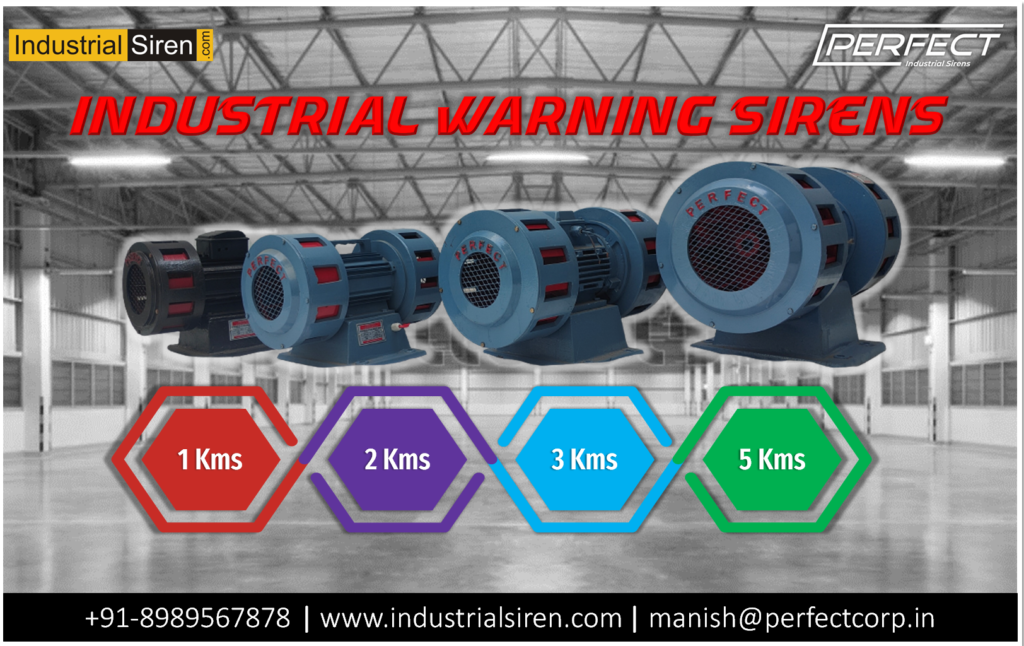In the realm of industrial safety, the importance of emergency sirens cannot be overstated. These auditory signals serve as critical tools in alerting and mobilizing personnel during emergencies, ensuring swift responses and mitigating potential hazards. In this comprehensive guide, we delve into the various types of industrial emergency sirens, their applications, and the diverse settings in which they play a pivotal role.

Perfect 1 2 3 5 Kms Emergency Sirens
Types of Industrial Emergency Sirens:
- Electric Motor Sirens:
- Electric motor sirens, also known as motor-driven sirens, utilize an electric motor to produce sound. These sirens are robust and reliable, capable of emitting high-decibel signals over large areas.
- Common applications include emergency declarations, fire alerts, and evacuation signals in industrial facilities, urban areas, and military installations.
- Hand Operated Sirens:
- Hand operated sirens, as the name suggests, require manual operation to generate sound. Typically, they feature a crank or lever mechanism that individuals can manually activate.
- These sirens are valuable in situations where power sources may be unavailable or compromised, such as remote locations or temporary setups during outdoor events.
- Electronic Sirens:
- Electronic sirens represent a modern evolution of emergency signaling technology. They rely on electronic circuitry to produce a range of warning tones and patterns.
- Electronic sirens offer versatility in terms of programmable functionalities, allowing for customized alert signals tailored to specific emergency scenarios.
Applications of Industrial Emergency Sirens:
- Emergency Declaration:
- Industrial facilities often use sirens to declare emergencies such as chemical spills, gas leaks, or equipment malfunctions, prompting immediate action and response protocols.
- Fire Alert:
- Sirens serve as crucial components of fire alarm systems, alerting occupants to the presence of fire and facilitating timely evacuation procedures.
- Evacuation Siren:
- During emergencies requiring evacuation, such as natural disasters or security threats, sirens provide audible cues for individuals to evacuate safely to designated assembly points.
- Automatic Timer-Based Factory Sirens:
- In manufacturing environments, timer-based sirens may be programmed to signal shift changes, break times, or specific operational phases, enhancing workflow efficiency.
- Press Start Warning Sirens:
- Press start warning sirens are employed in industrial machinery to alert operators before machinery or equipment initiates operation, minimizing the risk of accidents or injuries.
- Process Alert Sirens:
- Process alert sirens are utilized to signal deviations from normal operating conditions in industrial processes, prompting corrective actions to prevent potential hazards or production disruptions.
- General Purpose Sirens:
- General purpose sirens find application in a wide range of industrial settings, providing audible notifications for various safety-related events, maintenance activities, or security alerts.
Power Sources for Industrial Emergency Sirens:
- Three Phase 415V AC: Commonly used in industrial environments with robust power infrastructure, three-phase AC sirens offer reliability and consistency in sound output.
- 220V AC: Suitable for applications where lower voltage requirements are sufficient, 220V AC sirens are versatile and compatible with standard power outlets.
- 110V AC or 12/24V DC Battery Operated Sirens: Ideal for locations with limited access to mains power or as backup systems, sirens operating on 110V AC or battery power ensure continued functionality during power outages or emergencies.
Industrial emergency sirens are indispensable components of safety systems, providing audible alerts and warnings to protect lives, property, and assets in diverse settings. By understanding the types, applications, and power requirements of these sirens, organizations can enhance their emergency preparedness and response capabilities, fostering a safer and more secure working environment.
